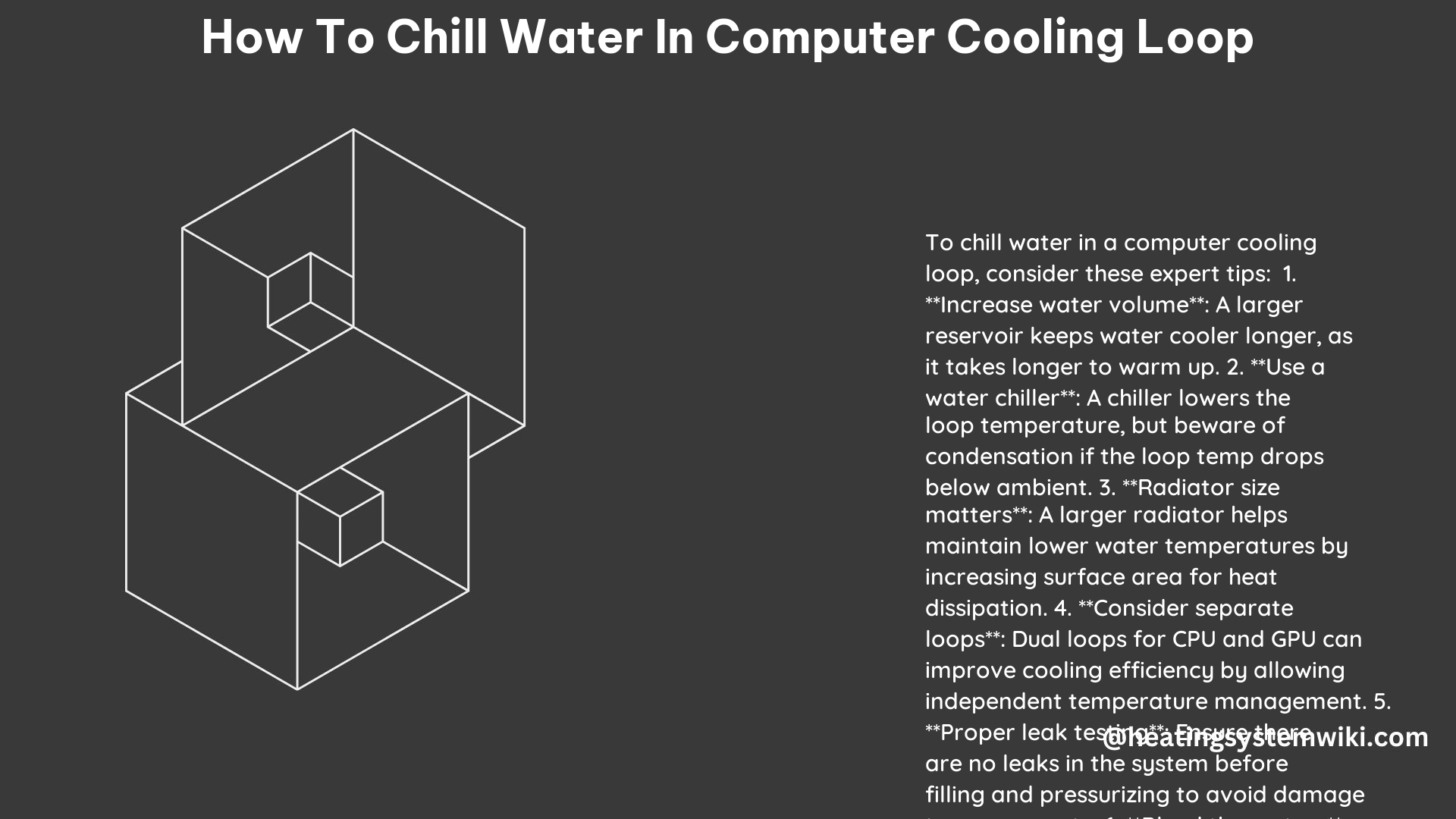Chilling water in a computer cooling loop is a crucial step to ensure optimal performance and longevity of your system. By using a water chiller, you can precisely control the temperature of the water circulating through your cooling loop, keeping your components running at their best. In this comprehensive guide, we’ll dive deep into the technical details and step-by-step instructions to help you effectively chill water in your computer cooling loop.
Understanding Water Chiller Specifications
Before we dive into the installation process, it’s essential to understand the key specifications of a water chiller that will impact its performance in your cooling loop.
Chiller Capacity
The chiller’s capacity is typically measured in watts or BTUs (British Thermal Units) and determines its ability to effectively cool the water in your loop. The required capacity will depend on the size of your cooling loop and the heat output of the components being cooled. As a general rule, you’ll want a chiller with a capacity that is at least 1.5 times the total heat output of your system.
Flow Rate
The flow rate of the chiller is measured in gallons per minute (GPM) or liters per minute (LPM) and determines how efficiently it can circulate the cooled water through your loop. The chiller’s flow rate should match or exceed the flow rate of your cooling loop to ensure proper heat transfer and temperature regulation.
Temperature Range
The temperature range of the chiller is crucial, as it determines the minimum and maximum temperatures it can maintain for the water in your loop. Look for a chiller with a wide temperature range, typically from 5°C (41°F) to 35°C (95°F), to accommodate a variety of cooling needs.
Noise Level
Some water chillers can be quite noisy, which can be a concern in a quiet office or home environment. Consider the noise level of the chiller, measured in decibels (dB), and choose a model with a low noise rating to minimize distractions.
Installing the Water Chiller

Now that you understand the key specifications, let’s dive into the step-by-step process of installing a water chiller in your computer cooling loop.
-
Prepare the Cooling Loop: Before installing the chiller, ensure that your existing water cooling loop is properly filled, bled, and functioning correctly. This will help prevent any issues during the chiller integration process.
-
Select the Chiller Location: Choose a suitable location for the water chiller, taking into account factors such as accessibility, ventilation, and proximity to your computer case. Ensure that the chiller will be positioned in a way that allows for easy maintenance and monitoring.
-
Connect the Chiller to the Loop: Follow the manufacturer’s instructions to connect the water chiller to your cooling loop. This typically involves using hoses to link the chiller’s inlet and outlet ports to the appropriate points in your loop.
-
Power the Chiller: Plug the water chiller into a power source and turn it on. Ensure that the chiller is receiving the correct voltage and that all electrical connections are secure.
-
Set the Desired Temperature: Use the chiller’s control panel or software to set the desired water temperature. As a general guideline, aim for a temperature that is 5-10°C (9-18°F) below the ambient temperature in the room.
-
Fill and Bleed the Loop: Once the chiller is installed and powered on, follow the instructions for your specific water cooling loop to fill it with coolant. Make sure to bleed the loop of any air bubbles to ensure proper circulation and heat transfer.
-
Power On the System: With the loop filled and bled, power on your computer system and allow the water to circulate through the loop. The chiller will automatically cool the water as it passes through, maintaining the set temperature.
-
Monitor the System: Keep a close eye on the water temperature and make any necessary adjustments to the chiller settings to ensure that the water stays at the desired temperature. You may need to fine-tune the chiller’s settings based on your system’s specific cooling requirements.
Troubleshooting and Maintenance
To ensure the long-term reliability and performance of your water chilling system, it’s essential to perform regular maintenance and address any issues that may arise.
Troubleshooting Common Issues
- If the water temperature is not reaching the desired level, check the chiller’s capacity and ensure that it is properly sized for your cooling loop.
- If the water temperature fluctuates or is unstable, inspect the chiller’s flow rate and ensure that it matches the requirements of your cooling loop.
- If the chiller is making excessive noise, check for any obstructions or blockages in the cooling system and ensure that the chiller is properly installed and ventilated.
Maintenance Procedures
- Regularly clean the chiller’s air filters and heat exchanger to maintain optimal airflow and heat dissipation.
- Check the coolant level in your cooling loop and top it up as needed to ensure proper circulation and heat transfer.
- Inspect the hoses and fittings in your cooling loop for any signs of wear or leaks, and replace them if necessary.
- Periodically test the chiller’s temperature sensors and control systems to ensure they are functioning correctly.
By following these guidelines and maintaining your water chilling system, you can ensure that your computer’s cooling loop continues to operate at peak efficiency, keeping your components running at their best.
Conclusion
Chilling water in a computer cooling loop is a crucial step in maintaining optimal system performance and longevity. By understanding the key specifications of a water chiller and following the step-by-step installation process, you can effectively integrate a chiller into your cooling loop and precisely control the temperature of the circulating water. Remember to regularly monitor and maintain your water chilling system to ensure its continued reliability and efficiency.
